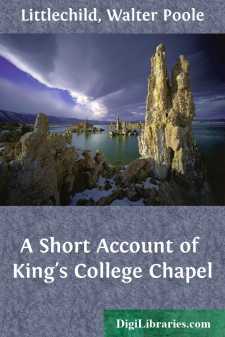Categories
- Antiques & Collectibles 13
- Architecture 36
- Art 48
- Bibles 22
- Biography & Autobiography 813
- Body, Mind & Spirit 142
- Business & Economics 28
- Children's Books 17
- Children's Fiction 14
- Computers 4
- Cooking 94
- Crafts & Hobbies 4
- Drama 346
- Education 46
- Family & Relationships 57
- Fiction 11829
- Games 19
- Gardening 17
- Health & Fitness 34
- History 1377
- House & Home 1
- Humor 147
- Juvenile Fiction 1873
- Juvenile Nonfiction 202
- Language Arts & Disciplines 88
- Law 16
- Literary Collections 686
- Literary Criticism 179
- Mathematics 13
- Medical 41
- Music 40
- Nature 179
- Non-Classifiable 1768
- Performing Arts 7
- Periodicals 1453
- Philosophy 64
- Photography 2
- Poetry 896
- Political Science 203
- Psychology 42
- Reference 154
- Religion 513
- Science 126
- Self-Help 84
- Social Science 81
- Sports & Recreation 34
- Study Aids 3
- Technology & Engineering 59
- Transportation 23
- Travel 463
- True Crime 29
A Short Account of King's College Chapel
Categories:
Description:
Excerpt
The Foundation
IN the year 1441 Henry VIfounded King's College for a Rector and twelve scholars. He remodelled his plan in 1443, and styled his foundation the College of St. Mary and St. Nicholas.It was to consist of a Provost, seventy Fellows, or Scholars, together with Chaplains, Lay Clerks, and Choristers. The court was originally on the north side of the present chapel opposite Clare College, and was the home of many generations of Kingsmen until about1825. In 1829 this court was sold to the University, and the buildings thereon were demolished to make way for an extension of the University Library; but the old entrance gateway was happily spared and incorporated with the new Library building, and stands there, as a "venerable and beautiful specimen of architecture," at the present day.On St. James' Day, July 25th, 1446, the King laid the foundation stone of the chapel, and so began a building which, as a distinguished member of the college (Lord Orford) said, would "alone be sufficient to ennoble any age." It has been classed with the chapel of Henry VII at Westminster and Saint George's collegiate church at Windsor, as one of "the three great royal chapels of the Tudor age"; but there is no edifice, except Eton College Chapel, which forms in any way a fair subject of comparison with that of King's College.
The style is rich perpendicular, marking the point where the last Gothic meets the early Renaissance. Nicholas Close has commonly been considered to be the architect. He was a man of Flemish family, and for a few years held the cure of the parish of St. John Zachary, which church stood on the west side of Milne Street, and probably so close to it that the high altar of the church was on ground afterwards enclosed within the western bays of the Ante-Chapel. Close, in 1450, was appointed to the See of Carlisle, and in 1452 transferred to Lichfield. He certainly received from the King the grant of a coat of arms for his services, but it might fairly be said that John Langton, Master of Pembroke College, and Chancellor of the University, who also had the title of "Surveyor," a term generally admitted to be synonymous with architect, has an equally strong claim. But Mr. G. G. Scott, in his essay on English Church Architecture, says "the man who really should have had the credit of conceiving this great work was the master-mason, Reginald Ely, appointed by a patent of Henry VI to press masons, carpenters, and other workers." According to Mr. Scott's view, "Close and his successors did the work which in modern days would be done, though less efficiently, by a building committee. But they were ecclesiastics, not architects; it is the master-mason, not the more dignified 'surveyor,' to whom the honour of planning the building should be attributed."
Looking East from Provost StallBESIDES the founder, whose misfortunes hindered the completion of his work, four successive kings aided in its erection. When Henry was taken prisoner at St....

